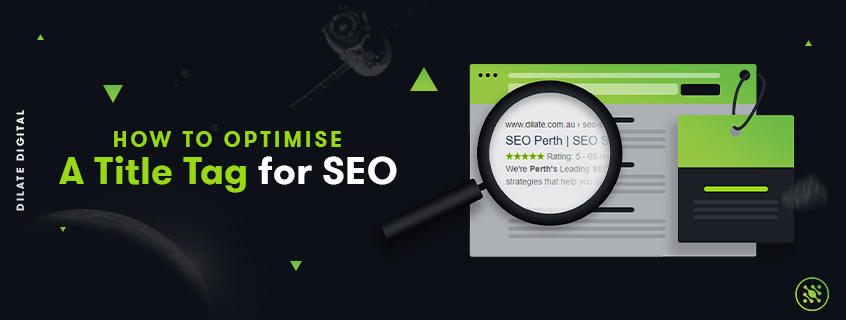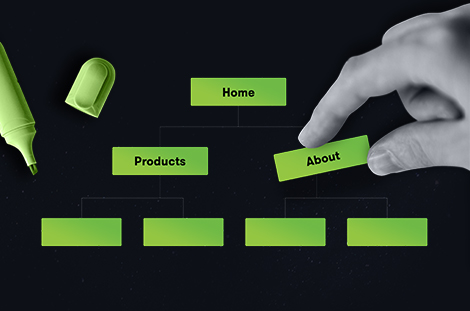

Title tags should be part of every SEO strategy, and in this post we’re going to show you how to optimise yours. But before we jump into how to make some killer title tags, let’s cover the basics like what are title tags? And are title tags a ranking factor?
Title tags are a type of meta tag (an HTML element). The other type of meta tag is the meta description. You’ll be familiar with these: you see them every time you search something in Google. Here’s one of our pages for SEO in Perth.

That big blue text - that’s the title tag. The black text under it - that’s the meta description. Title tags tell search engine users what the page on your website is about. It should deliver this information in a clear but concise way. Afterall, people only take a few seconds to decide if they’re going to click through onto your website. The title tag also appears in other places such as the web browser tab and when sharing on social media.
 Are Title Tags Important for SEO?
Are Title Tags Important for SEO?Think about the times you’ve typed something into Google. What makes you click through to a result? And what makes you skip over some? If you’re anything like the rest of us, the title tag probably plays a big role in your decision-making.
That’s because the title tag sticks out more than anything else in a list of search engine results. Searchers use it to decide very quickly what is relevant and what will lead them on a wild goose chase.
Beyond that, title tags are also an important on-page SEO element. That means your title tags are affecting your search engine ranking. And if you’re not ranking well, you won’t be seen. So yeah, title tags should be given a bit of attention.
We’ve put together a number of tips to help you get the most out of your title tags. Without further ado, let’s jump into them.
 1. Consider your website hierarchy
1. Consider your website hierarchy
Before you even begin writing your title tag, take a moment to think about where the page fits in the overall map of your website. Once you understand where each of your pages fits in, you’ll be able to create more effective title tags. And you’ll avoid repeating title tags, which we cover in tip number 4.
Some pages, e.g. the home page, are going to need a different title tag compared to a blog post. For easy navigation and clear communication, it is key to be consistent in title tag structure across similar types of pages. Generally, the lower the page in the hierarchy, the more specific your title tag should be.
 2. Be Topical
2. Be Topical
Your title tag needs to be relevant to the topic your page content is about. This one seems quite obvious, but you’d be surprised by how many people don’t do it. Think about it from a user’s point of view. If they click on a title promising them ‘How to Optimise a Title Tag for SEO’ but the information is about the services an SEO company offers, the user’s not going to be very happy.
Google wants to make users happy, so if your title tag is misleading or irrelevant, your ranking will be affected. The best title tags introduce the topic of the page and use the same important keywords that are used in the rest of the page content such as the copy, image alt attributes, meta description and the URL.
 3. Use the right keywords
3. Use the right keywords
Everyone knows the frustration of searching for something and getting results that don’t hit the nail on the head. No matter how great the content is, if it doesn't answer the question you asked, you won’t be satisfied. On the flipside, it can be equally as frustrating if you have amazing content, but it isn’t getting in the eyes of the right people.
Both of these issues have a lot to do with choosing the right keywords. If you don’t know what your audience is searching for, you’ll have to take a lucky guess, and you might guess wrong.
Keyword research is a really important step to improving your search engine ranking, and you shouldn’t skip it for title tags. Yeah, sure it’s not about hitting every single version of a keyword, but you can’t ignore searcher intent.
Your aim with title tags is to try and match the wording that your audience is using when they search. Try and put the main keywords in the first part of the title tag. Just make sure that when you’re using keywords you don’t compromise on the other tips we’re talking about in this article. Especially avoid keyword stuffing (see tip number 7).
 4. Be Unique
4. Be Unique
If you have identical titles on your website, you are essentially competing against yourself. It’s you versus you trying to rank for particular keywords. Give yourself a chance and don’t use identical title tags.
Often what happens when a website has identical title tags is that search engines choose to ignore the title tag and use other content in the search results. So that well-thought out title that you thought would engage searchers? It’s not even showing up. That’s probably going to have an impact on how many people choose to click through to your site.
Beyond SEO, having unique title tags is an important practice for better user experience. If you’re giving multiple pages the same title tag, it’s just going to get confusing for users. Be clear, and give them a better experience.
 5. Use Dynamic Options
5. Use Dynamic Options
Did you know that most website platforms automatically generate a title tag? If your website is really big or you have a lot of dynamic data, you can use this to your advantage by overriding the default, and coding it to suit your needs. This means you won’t have to manually manage thousands of title tags, and you can keep consistency across the different levels of your website hierarchy.
For example, if you sell products through your website, you could semantically code your product pages to have the same standard text plus the unique product name. In the example below, notice the product name is followed by standard text that is consistent across all Nike product pages on the website.

 6. Be Engaging
6. Be Engaging
Remember where your title tag shows up in the search results? You might hear this referred to as prime real estate. That blue link is a good spot: you don’t want to waste it on some sloppy, confusing writing. Give your page the best chance of being clicked on by writing really good title tags. We’ll walk you through how.
For starters, you might be wondering ‘how long should title tags be?’ Google limits them to 600 px, which translates to roughly 50-60 characters long. It’s not a lot of space, so you have to make sure you’re punchy and precise. Prioritise, get to the point, and stay on topic.
Use active language and calls to action rather than passive language that falls flat. Write to get an emotional response, and try using personal pronouns such as ‘you’ and ‘your’. Don’t get too complicated; your title tag should roll off the tongue easily. Whatever you do, make sure your title tag is focused on what your audience is searching for: that’s how you’re going to get their clicks.
 7. Be Human
7. Be Human
A massive turn off for a lot of people is language that sounds too salesy, too unnatural or too much like spam. Think: ‘SEO Title Tags. Optimising Title Tags. How to write Title Tags’. You’ll get this kind of title tag when people are trying to cram keywords in without giving any thought to sounding natural.
Google will penalise you for keyword stuffing, and it’s not very appealing for a user. That kind of thing turns people off because it doesn’t sound human. Building a trustworthy brand should be one of your top priorities, and a key way to achieve this is making your website users feel like there’s a person or team of people behind the content.
 8. Make it part of a broader SEO strategy
8. Make it part of a broader SEO strategy
We’ve spent a lot of time in this article talking about how important title tags are and why you should pay attention to them. However, it’s important to realise that they aren’t everything. Nailing your title tags isn’t enough to bring you SEO success: you’ve got to see them as one puzzle piece in a broader strategy.
Title tags work in partnership with many other elements on your website to help you improve your search engine rank. There are plenty of other things you should think about to improve SEO, because the best approach is a holistic one. If you want to dive deeper into optimising your website for SEO, there are plenty of awesome SEO blogs out there. But if you want to give your business the best chance at thriving online, we suggest getting in touch with an SEO service provider like Dilate Digital. We’ve helped hundreds of businesses get amazing results, and we can help you too. Get in touch with us today to see how.
what our clients are saying
create business. better everyday.
Let's Talklearn from the best minds in the business
Bodie provides some insight into Dilate's internal operations. How we approach what we do, and how we strive to be Better Everyday.

"*" indicates required fields


